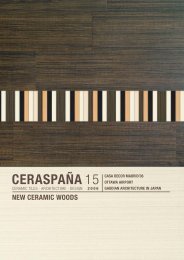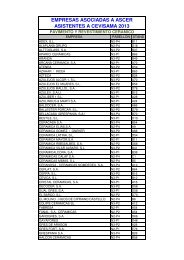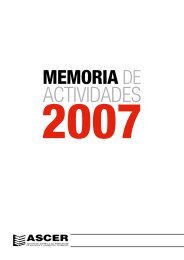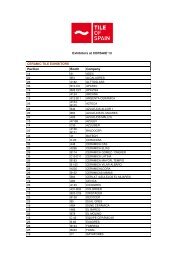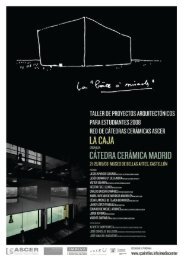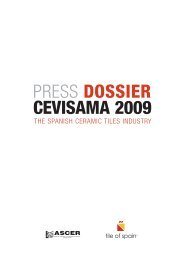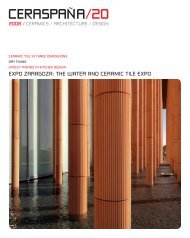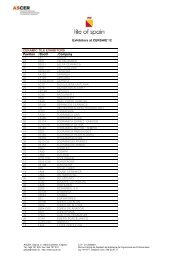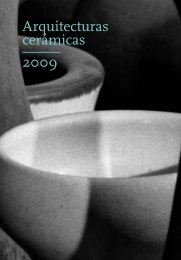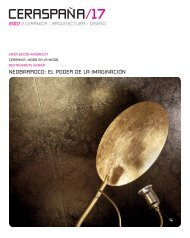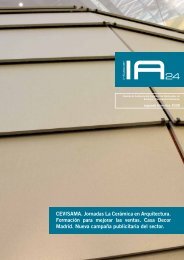PRESSDOSSIER - Tile of Spain
PRESSDOSSIER - Tile of Spain
PRESSDOSSIER - Tile of Spain
Create successful ePaper yourself
Turn your PDF publications into a flip-book with our unique Google optimized e-Paper software.
<strong>PRESSDOSSIER</strong><br />
THE SPANISH CERAMIC TILE INDUSTRY.<br />
CEVISAMA 2008
PRESS DOSSIER 1<br />
"TILE OF SPAIN” AT CEVISAMA 2008<br />
THE MOST IMPORTANT EXHIBITION FOR THE SPANISH CERAMIC TILE INDUSTRY IS SET TO TAKE PLACE FROM 5TH TO 9TH<br />
FEBRUARY IN VALENCIA<br />
CEVISAMA, the annual international exhibition for coverings for the construction industry, plumbing, bathroom fittings, raw materials,<br />
glazes and frits is in its 26 th year this year. Almost 140 ASCER member companies from the ceramic floor and wall tile manufacturing<br />
sector are exhibiting.<br />
THE INFORMATION CONTAINED IN THIS PACK COVERS:<br />
- <strong>Tile</strong> <strong>of</strong> <strong>Spain</strong>’s participation in CEVISAMA.<br />
- The Spanish ceramic tile industry in figures.<br />
- Leading edge Spanish ceramic tiles.<br />
- Ceramic tiles and Sustainability.<br />
- The network <strong>of</strong> Ceramic <strong>Tile</strong> Studies Departments<br />
- The VIth <strong>Tile</strong> <strong>of</strong> <strong>Spain</strong> Awards.<br />
- The new online press <strong>of</strong>fice for <strong>Spain</strong>’s ceramic tile industry.<br />
- <strong>Tile</strong> <strong>of</strong> <strong>Spain</strong> and R+D.<br />
- QUALICER 2008.<br />
- Images <strong>of</strong> new ceramic tile products on CD.<br />
- Press pack for the VIth <strong>Tile</strong> <strong>of</strong> <strong>Spain</strong> Awards including<br />
photographs, descriptions and plans.<br />
ASCER at CEVISAMA 2008:<br />
The Spanish Ceramic <strong>Tile</strong> Manufacturers’ Association (ASCER) is manning an information stand that will attend to all your enquiries<br />
regarding <strong>Spain</strong>’s ceramic tile industry, products and manufacturers. On the stand you will also be able to see the display <strong>of</strong> the best<br />
projects from the Ceramic <strong>Tile</strong> Studies Departments in Barcelona and Alicante.<br />
STAND Nº 26 LOBBY AREA LEVEL 2 (OPPOSITE TRANS/HITOS)<br />
ASCER · Ginjols, 3. 12003 Castellón (ESPAÑA) · tel.: +33 964 727 200<br />
fax: +33 964 727 212 · e-mail: comunicacion@ascer.es · web: http://www.spaintiles.info
CEVISAMA 2008:<br />
THE SHOWCASE FOR THE<br />
SPANISH TILE INDUSTRY<br />
The 26 th International Ceramic <strong>Tile</strong> and Bathroom<br />
Furnishings Exhibition, CEVISAMA, takes place from 5 th<br />
to 9 th February at the Feria Valencia exhibition centre.<br />
Almost 140 <strong>of</strong> ASCER’s members – ceramic tile<br />
manufacturers – will be exhibiting their very latest products<br />
at the event. As well as the ceramic tile industry the<br />
exhibition also includes exhibitors <strong>of</strong> coverings for the<br />
construction industry, plumbing, bathroom fittings, raw<br />
materials, glazes, frits and machinery.<br />
This year there will be more than 85,000 square metres <strong>of</strong><br />
display space. The ceramic tile-manufacturing sector will be
PRESS DOSSIER 3<br />
occupying 57% <strong>of</strong> the space, making it once again the major<br />
focus <strong>of</strong> the exhibition.<br />
CEVISAMA features a significant number <strong>of</strong> foreign exhibitors<br />
this year and it is also expected that the number <strong>of</strong><br />
International visitors will break last year’s record <strong>of</strong> 13,000<br />
pr<strong>of</strong>essionals from beyond our borders.<br />
Programme <strong>of</strong> parallel and promotional activities<br />
ASCER and ICEX have drawn up a programme <strong>of</strong> activities under<br />
the generic “<strong>Tile</strong> <strong>of</strong> <strong>Spain</strong>” banner as part <strong>of</strong> their promotional<br />
drive for Spanish ceramic tiles including, significantly, inviting
more than 100 trade journalists and specifiers from numerous<br />
countries to visit CEVISAMA.<br />
This year’s guests include specialist interior design, architecture<br />
and construction materials media from Australia, Germany,<br />
Bulgaria, France, Holland, Hungary, Ireland, Italy, Korea,<br />
Lithuania, Poland, Romania, Russia, Ukraine and the United<br />
Kingdom. The architecture world’s growing interest in ceramic<br />
wall and floor tiles, which are providing ever more construction<br />
solutions means that a significant number <strong>of</strong> the journalists<br />
invited are from architecture magazines. The international<br />
press visitor programme has been run in previous years and, as<br />
a result <strong>of</strong> the success achieved on the back <strong>of</strong> the invited<br />
press’ knowledge <strong>of</strong> and engagement with the Spanish tile<br />
industry, has become one the main mechanics for promoting the<br />
industry to specifiers internationally.
PRESS DOSSIER 5<br />
ASCER’s stand at the fair (opposite Trans/Hitos) will also be<br />
hosting “Expocátedra”, an exhibit <strong>of</strong> the best projects by<br />
students at the Ceramic <strong>Tile</strong> Studies Departments within the<br />
Barcelona and Alicante Schools <strong>of</strong> Architecture.<br />
ASCER has published a special CEVISAMA issue <strong>of</strong> its trade<br />
magazine “Ceraspaña”, in English, French, German, Russian<br />
and Spanish versions. Circulation <strong>of</strong> the magazine, which is<br />
distributed in more than 60 countries, focuses on those markets<br />
where there is a specific promotional plan running, namely<br />
Germany, France, the United States, the Russian Federation and<br />
the United Kingdom.<br />
CEVISAMA INDI’s Architecture, Design and Interior Design<br />
Forum<br />
CEVISAMA INDI will be staging the Architecture and Design Forum<br />
from 6 th to 8 th February. The Forum aims to be a place where<br />
pr<strong>of</strong>essionals in the fields <strong>of</strong> architecture, design and interior<br />
design can meet and discuss issues <strong>of</strong> interest. The Forum will<br />
feature lectures by distinguished speakers including architects,<br />
interior designers and designers <strong>of</strong> international renown.<br />
CONFERENCES<br />
ASCER will once again be holding its traditional international<br />
press conference where it will reveal the Spanish ceramic tile<br />
industry’s main results and the projects set to be rolled out over<br />
the year that has just begun. Following the conference the<br />
winners <strong>of</strong> the VIth <strong>Tile</strong> <strong>of</strong> <strong>Spain</strong> Awards will be announced, with<br />
prizes being given in four categories: Architecture, Interior<br />
Design, Degree Projects and Journalism.<br />
6th FEBRUARY<br />
Interiors’ Design Day<br />
7th FEBRUARY<br />
Architecture’s Day<br />
8th FEBRUARY<br />
Design’s Day
THE SPANISH CERAMIC TILE<br />
INDUSTRY IN FIGURES<br />
Essential information on the Spanish tile industry<br />
<strong>Spain</strong>’s ceramic floor and wall tile manufacturing industry<br />
is one <strong>of</strong> the country’s most dynamic and innovative. It<br />
is also one <strong>of</strong> the leading tile industries at global level in<br />
terms <strong>of</strong> technological development, design and quality <strong>of</strong><br />
service.<br />
<strong>Spain</strong> is Europe’s leading producer <strong>of</strong> ceramic tiles and<br />
accounted for 38.5% <strong>of</strong> the EU-27 countries’ output in 2006,<br />
whilst <strong>Spain</strong>’s exports account for 19.3% <strong>of</strong> all international<br />
trade. In <strong>Spain</strong>, the ceramic tile industry represents 0.13% <strong>of</strong><br />
total GDP and 1.3% <strong>of</strong> <strong>Spain</strong>’s total overseas trade.<br />
The ceramic tile industry contributes a definite trade surplus<br />
for <strong>Spain</strong>. In 2006 the value <strong>of</strong> this surplus was 2,061 million<br />
euros, thanks to exports valued at 2,183 million euros.<br />
In 2007 the Spanish tile industry turned over 4,120 million<br />
euros (estimated), 3.4% up on 2006. Around 56% <strong>of</strong> the<br />
industry’s total turnover corresponds to exports, with the<br />
balance <strong>of</strong> sales being to the domestic market.
PRESS DOSSIER 7<br />
The industry’s exports in 2007 – to over 190 different countries<br />
– were valued at 2,300 million euros, up 5.4% on the previous<br />
year.<br />
industry has one <strong>of</strong> the most stable levels <strong>of</strong> employment:<br />
between 85% and 88% <strong>of</strong> work contracts are permanent and in<br />
some companies the rate is closer to 100%.<br />
The sales in domestic market were valued at 1,802 million<br />
euros (+1%). <strong>Spain</strong> is the biggest consumer in Europe and has<br />
the world’s highest per capita consumption.<br />
In 2007 the industry’s output was 585 million square meters<br />
approximately. <strong>Spain</strong> is one <strong>of</strong> the world’s largest producers <strong>of</strong><br />
ceramic tiles and the leading producer in Europe, with a 38.5%<br />
share <strong>of</strong> the EU-27’s output in 2006.<br />
In 2007 the industry comprised around 200 manufacturers <strong>of</strong><br />
ceramic tiles. Twenty or so companies specialising in atomizing<br />
clay and making biscuit should be added to this figure. It is<br />
estimated that as a whole the ceramic tile industry provides<br />
direct employment for approximately 26,400 workers and<br />
that it generates indirect employment for around 7,000 more, in<br />
companies that, by and large, are SMEs. The ceramic tile<br />
One <strong>of</strong> the Spanish tile industry’s main features is that it is<br />
highly concentrated in the province <strong>of</strong> Castellón, especially in<br />
the area that is bounded by Alcora and Borriol to the north, Onda<br />
to the west, Nules to the south and Castellón de la Plana to the<br />
east. Approximately 94% <strong>of</strong> domestic production originates from<br />
this province, where 81% <strong>of</strong> manufacturers are located.<br />
The ceramic tile industry is the Comunidad Valenciana’s<br />
biggest investor, accounting for 15.7% <strong>of</strong> all investment in<br />
industry in the Comunidad Valenciana and 47% in the province<br />
<strong>of</strong> Castellón according to estimates made from data provided by<br />
the Valencian Government. The ceramic tile industry is the<br />
second biggest wealth generator in the Comunidad<br />
Valenciana, <strong>of</strong> a total <strong>of</strong> 104 sectors analysed. It is second only<br />
to retailing (major multiple and independent retailers), according<br />
to the 2004 Ardán study carried out by Impiva.<br />
BASIC ECONOMIC DATA 2007 (ESTIMATED)<br />
Production<br />
• 585 millon m 2<br />
• EU share: 28,5%<br />
• 94% <strong>of</strong> domestic output is<br />
concentrated in the province <strong>of</strong><br />
Castellón<br />
Exports<br />
• to 190 countries<br />
• 2,300 millions €<br />
• Share <strong>of</strong> global trade: 19%<br />
Domestic sales<br />
• 1,820 million €<br />
Imports<br />
• 160 millions €<br />
Employment<br />
• 26,400 in direct employment<br />
• 7,000 in direct employment<br />
Total sales<br />
• Estimated value: 4,120 millions €<br />
* Estimated
SPANISH CERAMIC TILES: A LEADING<br />
EDGE PRODUCT AND INDUSTRY<br />
One <strong>of</strong> the features <strong>of</strong> <strong>Spain</strong>’s ceramic tile industry is that<br />
it is immensely dynamic and in constant development<br />
on both the technological and the design fronts. This<br />
makes it essential to keep specifiers (architects, interior<br />
designers, builders, retailers, etc.) and the end user abreast <strong>of</strong><br />
the industry’s new products. Ceramic is a material that is<br />
looking to move ahead, stepping outside the box <strong>of</strong> the domestic<br />
environment to <strong>of</strong>fer unlimited architectural solutions for<br />
facades, urban spaces, public surfaces, industrial applications,<br />
ro<strong>of</strong>s, heated flooring and more.<br />
ASCER organises a multitude <strong>of</strong> activities and events designed<br />
to increase awareness and knowledge amongst consumers and<br />
specifiers and provide training for the latter. All are part <strong>of</strong> a<br />
promotional drive that is rolled out not just in <strong>Spain</strong> but<br />
worldwide too.<br />
TILE OF SPAIN AROUND THE WORLD…<br />
Batimat Exhibition (París)<br />
Spanish floor and wall tiles can be found in over 190 countries<br />
around the world. The industry is working daily to boost its<br />
presence in a number <strong>of</strong> marketplaces, organising a variety <strong>of</strong><br />
promotional activities not just in those countries where there<br />
is a specific promotion plan in place (France, USA, UK,<br />
Germany and Russia) but also throughout the rest <strong>of</strong> the world.<br />
Under the generic <strong>Tile</strong> <strong>of</strong> <strong>Spain</strong> brand, the industry works all<br />
over the world to promote knowledge, the use and the image<br />
<strong>of</strong> Spanish tiles.<br />
Coverings Exhibition (Chicago, USA.)
PRESS DOSSIER 9<br />
Workshop<br />
Ceramic is a creative, versatile product that <strong>of</strong>fers architectural<br />
and construction solutions that combine design with high<br />
technical specifications. One <strong>of</strong> the main target audiences for<br />
the overseas promotion plan, therefore, is specifiers (architects<br />
and interior designers).<br />
Participation in international exhibitions. The main events the<br />
industry exhibits at are: CERSAIE (Bologna, Italy), COVERINGS<br />
(Orlando, USA), MOSBUILD (Moscow, Russia), SURFACES (Las<br />
Vegas, USA) and NEOCON CHICAGO (Chicago, USA). As well as<br />
these four shows, where the companies exhibit themselves, the<br />
industry has been represented, by means <strong>of</strong> an information<br />
stand, at the AIA Convention in Los Angeles (USA), the <strong>Tile</strong> and<br />
Stone Show (London, United Kingdom), the NEOCON interiors<br />
and design fair (Canada) and BATIMAT Paris.
The Spanish industry’s commitment to innovation and design<br />
has managed to extend the range <strong>of</strong> uses and potential uses for<br />
ceramic tiles in construction. This has prompted <strong>Tile</strong> <strong>of</strong> <strong>Spain</strong> to<br />
run workshops designed to raise awareness <strong>of</strong> the<br />
architectural and aesthetic merits <strong>of</strong> ceramic tile amongst<br />
architects and interior designers. A good example is the United<br />
States, where <strong>Tile</strong> <strong>of</strong> <strong>Spain</strong> is accredited by the AIA to lead<br />
seminars that gain architects course credits and that we run in<br />
an ongoing collaboration with an expert in training in ceramic<br />
tiles. As a result we can run extensive seminars at the same<br />
time as trade fairs and distributors’, fixers’ and contractors’<br />
conventions.<br />
An advertising campaign with the strapline “Be creative” is<br />
being rolled out to promote the image <strong>of</strong> Spanish ceramic tile<br />
products in foreign markets. The campaign, which is running in<br />
the main tile trade, architecture and interior design magazines<br />
across the world includes advertisements and advertorials<br />
themed on trends and promotes the qualities <strong>of</strong> ceramic tile as<br />
a material.<br />
<strong>Tile</strong> <strong>of</strong> <strong>Spain</strong> uses advertising agencies based in the USA,<br />
Germany, the United Kingdom, France and the Russian<br />
Federation that manage the communication and public<br />
relations with the specialist press. The agencies also manage<br />
inbound trade missions to the “ceramic tile cluster” to visit<br />
production facilities and projects where ceramic tiles play a<br />
pivotal part and are a clear point <strong>of</strong> difference.<br />
TRADE PUBLICATION: CERASPAÑA MAGAZINE<br />
AND 2ND EDITION OF BOOK ON<br />
ARCHITECTURE AND CERAMIC TILES.<br />
<strong>Tile</strong> <strong>of</strong> <strong>Spain</strong> has a major tool that is part <strong>of</strong> its substantial effort<br />
to promote and educate about ceramic tiles: the promotional<br />
magazine “Ceraspaña.” Published in Spanish, English, French,<br />
German and Russian it is distributed by direct, personalised<br />
mailing to over 63,000 postal addresses in upward <strong>of</strong> 40<br />
countries. It is also handed out at trade fairs and other events<br />
at which <strong>Tile</strong> <strong>of</strong> <strong>Spain</strong> has a presence.<br />
In addition to its print run <strong>of</strong> 63,500 copies, a digital version <strong>of</strong><br />
the magazine is available too via the sector’s online press <strong>of</strong>fice:<br />
www.spaintiles.info/mediacenter<br />
Following the success <strong>of</strong> its first book on architecture,<br />
“Moulding. Assembling. Desining. Ceramics in Architecture”,<br />
which was published by ASCER in 2006 the Association, in
PRESS DOSSIER 11<br />
The Promotion Plan includes an ongoing assessment and<br />
analysis <strong>of</strong> the main export markets and also the supply <strong>of</strong> data<br />
to exporters through market research and workshops.<br />
Another <strong>of</strong> the tools used by the Export Promotion Plan is the<br />
<strong>Tile</strong> <strong>of</strong> <strong>Spain</strong> Website. Available in English, French, German<br />
and Spanish, as well as giving information on the industry and<br />
the various promotional activities being rolled out in <strong>Spain</strong> and<br />
internationally, the site <strong>of</strong>fers a service whereby trade enquiries<br />
are forwarded instantly to Ascer´s members.<br />
…AND IN SPAIN<br />
collaboration with publishers Actar, is preparing the book’s<br />
second volume. Titled “Public. Private. Ephemeral. Ceramics in<br />
Architecture”, the book reviews a broad spectrum <strong>of</strong><br />
architecture, town planning and interior design projects in which<br />
ceramic tiles play a defining role.<br />
Five out <strong>of</strong> every ten tiles made in <strong>Spain</strong> remains in the<br />
domestic market. In 2007 domestic sales hit according to<br />
estmations, 1,840 million euros, making <strong>Spain</strong> the world’s<br />
leading per capita consumer.
Since 2005 the Spanish ceramic tile industry has been running a<br />
joint promotion plan across <strong>Spain</strong> in conjunction with ASCER that<br />
aims to position ceramic wall and floor tiles as a cutting edge,<br />
innovative and versatile choice. There are no limits to ceramic<br />
tiles in terms <strong>of</strong> design, uses, colours, formats and shapes,<br />
spaces, effects, relief decor etc. The only limitation is the user’s<br />
and the project manager’s imagination... The ambitious Plan is<br />
still being implemented and in 2007 again included a television<br />
and magazine advertising campaign again plus a number <strong>of</strong><br />
public relations events and awareness-raising initiatives targeted<br />
at specifiers. The industry was thus represented at both the<br />
Madrid and the Barcelona Casa Decor events in 2007. The <strong>Tile</strong><br />
<strong>of</strong> <strong>Spain</strong> Awards competition was held again too, training<br />
seminars and workshops were run for the architecture and<br />
interior design press and students <strong>of</strong> architecture respectively<br />
and, amongst other things, the Network <strong>of</strong> Ceramic <strong>Tile</strong> Studies<br />
Departments in Schools <strong>of</strong> Architecture was extended.<br />
CERAMIC TILES A MAJOR FEATURE OF CASA<br />
DECOR<br />
In spring, the “Ceramic Concert” space designed by famous<br />
architect and interior designer Tomás Alía amazed visitors to<br />
Casa Decor Madrid with its six spectacular ceramic tile<br />
skyscrapers. According to Alía, it was the versatility <strong>of</strong><br />
Spanish ceramic tiles that enabled him to give full vent to his<br />
creativity.<br />
In Barcelona, eminent architect Xavier Claramunt devised an<br />
unusual space that he called “Ceramic tiles in motion”. This<br />
was an unprecedented project as it managed to give<br />
movement to the ceramic tiles through the most innovative<br />
applications <strong>of</strong> robotics. Ceramic tiles were, without a shadow<br />
<strong>of</strong> a doubt, the essence and shining star <strong>of</strong> this new creation.<br />
According to Claramunt “has a thousand faces, none <strong>of</strong> which<br />
needs even a millimetre <strong>of</strong> cosmetic surgery” enabled the<br />
architect to produce a truly original piece <strong>of</strong> work.<br />
“Ceramic tiles in motion” was an undulating structure made <strong>of</strong><br />
small ceramic tiles that swayed gently back and forth, creating<br />
a s<strong>of</strong>t play <strong>of</strong> light.<br />
Taking part in both the Madrid and the Barcelona versions <strong>of</strong><br />
Casa Decor, <strong>Spain</strong>’s leading decorating and interior design<br />
event, was one <strong>of</strong> the campaign’s most unusual elements.<br />
Ceramic Concert, Casa Decor Madrid 2007
PRESS DOSSIER 13<br />
Ceramic tiles in motion, Casa Decor Barcelona 2007
AN INDUSTRY PLOUGHING THE FURROW<br />
OF SUSTAINABLE DEVELOPMENT<br />
The ceramic tile industry is taking steps to make its activity<br />
environmentally responsible. Whilst what it is doing may<br />
not be visible to the rest <strong>of</strong> society, the sector is making<br />
an enormous and significant effort to collaborate in the<br />
sustainable development <strong>of</strong> our planet.<br />
is has already made in this area have led its rate <strong>of</strong> water<br />
consumption per square metre to be lower than the optimum<br />
that has been set for the industry in Europe. What is more,<br />
effluent is now nil in many cases, which has helped improve<br />
the quality <strong>of</strong> our water.<br />
During the three-year period 2005-07 the industry achieved<br />
reductions in CO2 emissions that place it in the vanguard <strong>of</strong><br />
the global league table for compliance with the Kyoto<br />
Protocol. The technical and financial effort the industry has<br />
invested is one that not all producers are embracing and has<br />
made <strong>Spain</strong>’s ceramic tile industry a beacon amongst its<br />
competitors.<br />
<strong>Spain</strong>’s ceramic tile manufacturers have also managed to<br />
reduce their energy consumption whilst maintaining their<br />
output, achieving the best energy efficiency ratio per unit <strong>of</strong><br />
production <strong>of</strong> the world’s entire ceramic tile industry. This is<br />
all due to a change that began to take place in the early 80’s<br />
with the introduction <strong>of</strong> natural gas to the manufacturing<br />
process and has led to rates <strong>of</strong> energy efficiency that are<br />
without comparison amongst our competitors. The sector has<br />
also pioneered the application <strong>of</strong> co-generation as a means <strong>of</strong><br />
increasing efficiency and savings in its industrial processes.<br />
The technique was introduced in the mid 1980’s and has<br />
achieved an overall energy saving <strong>of</strong><br />
over 75% along with a saving <strong>of</strong> primary<br />
energy above 10%. There are currently<br />
80 co-generation plants up and running<br />
that produce 1,500 GW a year for the<br />
sector’s own consumption. Cogeneration<br />
is one <strong>of</strong> the so-called “best<br />
available technologies”. <strong>Spain</strong>’s<br />
ceramic tile industry is already using<br />
these technologies in a bid to be more<br />
energy efficient and more<br />
environmentally responsible.<br />
Target: “zero waste”<br />
<strong>Spain</strong>’s ceramic tile industry is investing its main efforts in<br />
the area <strong>of</strong> waste management. In the stages <strong>of</strong> manufacture<br />
prior to firing, 100% <strong>of</strong> waste is re-used, as it is<br />
reincorporated into the raw material preparation circuit. After<br />
the firing stage the waste generated can be ground up and<br />
used as a covering or ground up and reincorporated into the<br />
manufacturing process. Waste from construction or<br />
demolition can also be recycled and used as bases or subbases<br />
for paving or as grains for making cement. The<br />
industry is pursuing these lines <strong>of</strong> work to achieve “zero<br />
waste”.<br />
The new and revolutionary “dry fixing systems” that the<br />
industry is developing resolve another problem, that <strong>of</strong> the<br />
difficulty <strong>of</strong> re-using tiles once they have been anchored to<br />
floors or walls, as the new systems allow the ceramic material<br />
to be used quickly and simply.<br />
Rational use <strong>of</strong> water in our country is<br />
also on the Spanish tile industry’s<br />
environmental agenda. The efforts that
PRESS DOSSIER 15<br />
There is a definite commitment to<br />
demanding a higher performance from<br />
the product and to exploiting its intrinsic<br />
qualities with a view to contributing to<br />
sustainable development.<br />
This versatility gives ceramic tiles an<br />
enormous capacity to imitate other<br />
materials such as marble and wood,<br />
which means they can be substituted for<br />
materials <strong>of</strong> limited availability – as is the<br />
case with precious woods – and<br />
contribute to preserving and protecting<br />
the planet’s forests.<br />
Extending the useful life <strong>of</strong> a building promotes a reduction in<br />
the total amount <strong>of</strong> waste, which is a prerequisite for a<br />
building to be considered sustainable. Ceramic resists the<br />
passage <strong>of</strong> time like no other material so is a perfect example<br />
<strong>of</strong> the notion <strong>of</strong> durability. All the ancient civilisations used<br />
ceramic in their buildings and it has come down to us today<br />
as a material that is a part <strong>of</strong> <strong>Spain</strong>’s Roman and Andalusian<br />
heritage. This abiding quality <strong>of</strong> ceramic tile is a major<br />
attribute in its favour as a sustainable material.<br />
An all-purpose, versatile material<br />
Another key feature that makes ceramic tile a sustainable<br />
material is that it is all-purpose, something that has for<br />
example encouraged the development <strong>of</strong> larger formats that<br />
have helped, amongst other things, save resources in the<br />
installation process. The large formats have also become one<br />
<strong>of</strong> architects’ preferred choices. The all-purpose nature <strong>of</strong><br />
ceramic tiles has enabled them to move on from being simply<br />
covering interiors: now they rule over spaces that were<br />
previously the preserve <strong>of</strong> other materials and in these<br />
spaces they have demonstrated their versatility and ability to<br />
be used for all purposes.<br />
An industry that creates quality <strong>of</strong> life<br />
on the socio-labour front<br />
The Spanish ceramic tile industry is<br />
concentrated in a cluster in a well-defined geographical area.<br />
81% <strong>of</strong> the industry, accounting for 94% <strong>of</strong> total output, is<br />
based in the province <strong>of</strong> Castellón. The industry is a major<br />
employer with over 26,000 employees and a high quality <strong>of</strong><br />
socio-labour life, as is evidenced by the statistic that between<br />
85% and 88% <strong>of</strong> all labour contracts are permanent.<br />
The geographical concentration <strong>of</strong> manufacturing in Castellón<br />
has also meant that companies are heavily involved with their<br />
immediate surroundings. Thus, the tile companies’ corporate<br />
social responsibility initiatives in the towns where they are<br />
based are totally integral to their business policy.<br />
Ceramic tiles have migrated outside buildings and are now<br />
used to cover ventilated facades, thanks to the contribution<br />
they can make to provide thermal insulation, thereby reducing<br />
the amount <strong>of</strong> energy consumed in air-conditioning the<br />
spaces within. Studies have shown that using ceramic tiles<br />
on ventilated facades can achieve energy savings <strong>of</strong> 30%.
NETWORK OF CERAMIC TILE STUDIES<br />
DEPARTMENTS<br />
The various Ceramic <strong>Tile</strong> Studies Departments and Ceramic <strong>Tile</strong><br />
“Classrooms” in Advanced Schools <strong>of</strong> Architecture and Project<br />
Management in <strong>Spain</strong> are reaping very good rewards and<br />
creating a very favourable current <strong>of</strong> opinion amongst<br />
architects. The aim <strong>of</strong> the Network <strong>of</strong> Ceramic <strong>Tile</strong> Studies<br />
Departments is to promote and develop, within a university<br />
environment, training and research initiatives and initiatives to<br />
promote ceramic tiles to society at large.<br />
The Network currently extends to the Advanced Schools <strong>of</strong><br />
Architecture in Barcelona, Alicante, Valencia and Madrid and the<br />
Castellón School <strong>of</strong> Project Management.<br />
This academic year has also seen the start <strong>of</strong> a working<br />
partnership with Harvard University whereby top students <strong>of</strong><br />
architecture from all over the world got to know our industry<br />
and took part in an Innovation Workshop on designing ceramic<br />
tiles. They then went on to work on a project that was<br />
supervised by the director <strong>of</strong> the initiative, architect Patxi<br />
Mangado.<br />
“Expocátedras” (Departmental exhibitions) <strong>of</strong> the best work by<br />
students from several parts <strong>of</strong> <strong>Spain</strong> are staged so as to raise<br />
awareness <strong>of</strong> the work being done by the Departments. Last<br />
year Expocátedras took place at CEVISAMA, at the Guild <strong>of</strong><br />
Architects <strong>of</strong> Alicante and at FAD (Fomento de las Artes y el<br />
Diseño – Promotion <strong>of</strong> the Arts and Design) in Barcelona.
PRESS DOSSIER 17<br />
Students from Harvard<br />
Visits to factories<br />
The Ceramic <strong>Tile</strong> Studies Departments focus on classic<br />
teaching, although training and education are also delivered<br />
through lectures and publications on understanding <strong>of</strong> and<br />
diversification in the use <strong>of</strong> ceramic tiles in the field <strong>of</strong><br />
architecture.<br />
Doctor <strong>of</strong> Architecture Vicente Sarrablo heads the pioneering<br />
Ceramic <strong>Tile</strong> Studies Department at ESARQ at the International<br />
University <strong>of</strong> Catalonia, which is now in its fourth year. In<br />
Alicante the Department headed by Víctor Echarri, who is also a<br />
Doctor <strong>of</strong> Architecture, is focusing this year (its third) on<br />
sustainability in construction. In previous years Alicante<br />
students have looked at other subjects such as designing<br />
solutions with porcelain stoneware for housing natural gas<br />
installations (Porcelagas) and air conditioning systems<br />
(Climagres) in buildings. The Madrid School <strong>of</strong> Architecture has<br />
become part <strong>of</strong> the Network this year, by setting up a Ceramic<br />
<strong>Tile</strong> Studies Department. Headed by doctor <strong>of</strong> architecture<br />
Jesús Aparicio, this latest addition to the Network concentrates<br />
on more theoretical aspects <strong>of</strong> architectural ceramics.<br />
ASCER, on the other hand, has set up a Ceramic <strong>Tile</strong><br />
“Classroom” in the Castellón School <strong>of</strong> Project Management at<br />
Jaime I University, which gives students specialist technical<br />
training in subjects related to ceramic tiles.<br />
Architects <strong>of</strong> wide renown visit the Ceramic <strong>Tile</strong> Studies Departments and give lectures
VI TH TILE OF SPAIN<br />
AWARDS OF<br />
ARCHITECTURE AND<br />
INTERIOR DESIGN<br />
The jury judging the <strong>Tile</strong> <strong>of</strong> <strong>Spain</strong> Awards <strong>of</strong> Architecture<br />
and Interior Design competition met last November in<br />
Castellón. The jury was chaired by Portuguese architect<br />
Eduardo Souto de Moura. The competition, in its sixth year last<br />
year, has beaten all records with double the number <strong>of</strong> entries<br />
received: 100.<br />
The prize fund in the architecture category <strong>of</strong> the competition is<br />
20,000 Euros, with 20,000 in the interior design category and<br />
10,000 Euros in the Degree Projects category. Gas Natural,<br />
Vodafone <strong>Spain</strong> and the Port Authority <strong>of</strong> Valencia have<br />
supported the initiative, whose purpose is to promote and attach<br />
a perception <strong>of</strong> prestige to the use <strong>of</strong> ceramic tiles in<br />
architecture and interior design.<br />
The jury decided unanimously to award first prize in the<br />
Architecture category to “Colour Revolution”, a project by José<br />
Durán Fernández. “The jury is impressed that with just two<br />
materials – colour and ceramic tile – the architect has given the<br />
street a new urban identity.” The project involved a re-design <strong>of</strong>
PRESS DOSSIER 19<br />
1 2<br />
San Vicente Street in Burriana (Castellón, <strong>Spain</strong>), in which<br />
ceramic tiles were the star feature. The jury made the award on<br />
the basis <strong>of</strong> the “coherence in the use <strong>of</strong> materials outside and<br />
inside, including ceramic tile as a mirror to reflect the light<br />
through patios and skylights.”<br />
First prize in the Interior Design category went to the “San Blas<br />
Municipal Health Centre” in Madrid by María Hurtado de Mendoza<br />
Wahrolén, César Jiménez de Tejada Benavides and José María<br />
Hurtado de Mendoza Wahrolén at the Entresitio studio.<br />
Lastly, the competition includes a category designed to give<br />
recognition to the best Degree Project undertaken by a student<br />
at either a Spanish or a foreign school <strong>of</strong> architecture in which<br />
ceramic tiles are a major component. The jury elected to award<br />
first prize to the “C_DAC Contemporary Architecture<br />
Documentation Centre” by Sergio Bruns Banegas. The jury was<br />
particularly struck by “the fact that the urban setting determined<br />
the project’s strategy, in which ceramic tile is used in a way that<br />
is consistent with its urban setting. The project’s inventiveness<br />
and daring was also highly valued.”
3<br />
The jury awarded an Honorary Mention to the “Palencia Law<br />
Courts” by Isabel García Vázquez. The main feature <strong>of</strong> this<br />
project, jury pointed out, is that it is “a disquieting assemblage<br />
<strong>of</strong> boxes where the quality <strong>of</strong> the ceramic tiles and the light<br />
guide the viewer and give order to the labyrinth.”<br />
including Rafael de La-Hoz; Jacob Van Rijs <strong>of</strong> the MVRDV studio<br />
in Holland; Felipe Pich-Aguilera <strong>of</strong> Pich Architects; Canary<br />
Islander Fernando Menis; Catalan architect Mercé Berengué, <strong>of</strong><br />
Roldán+Berengué; and Ramón Monfort, president <strong>of</strong> the<br />
Castellón Association <strong>of</strong> Architects.<br />
The <strong>Tile</strong> <strong>of</strong> <strong>Spain</strong> Awards have evolved significantly thanks to<br />
the increasing quality <strong>of</strong> the work entered for the competition<br />
and its growing popularity. The winning entries in the<br />
architecture category for the last few years include: the<br />
Spanish Pavilion at the Aichi Expo in Japan (by Alejandro Zaera<br />
and Farshid Moussavi, FOA Architects), the renovation <strong>of</strong> Santa<br />
Caterina Market in Barcelona (by Enric Miralles and Benedetta<br />
Tagliabue, EMBT Arquitectes), the Peñíscola Conference Centre<br />
(by Ángela García Paredes and Ignacio García Pedrosa) and the<br />
Castilla La Mancha Archives in Toledo by Guillermo Vázquez<br />
Consuegra.<br />
Full information on the Awards can be found in<br />
the enclosed press pack and on the website:<br />
http://www.spaintiles.info/awards<br />
4<br />
This year the jury was chaired by eminent Portuguese architect<br />
Eduardo Souto de Moura. Members included leading architects
PRESS DOSSIER 21<br />
5<br />
5 5<br />
6<br />
1. First Prize Interior Design: “San Blas<br />
Municipal Health Centre<br />
2 y 3. First Prize Architecture: “Colour<br />
Revolution”<br />
4. Jury<br />
5. First Prize Degree Projects: “C_DAC<br />
(Contemporary Architecture Documentation<br />
Centre)<br />
6. Honourable mention Degree Projects: “The<br />
Palencia Law Courts”
WWW.SPAINTILES.INFO: THE SOURCE<br />
OF INFORMATION ON THE INDUSTRY<br />
ASCER recently re-designed the Press Office section <strong>of</strong> its<br />
website, www.spaintiles.info adding new content and<br />
functions in a bid to make it the source <strong>of</strong> information on<br />
<strong>Spain</strong>’s ceramic tile industry for both the press – Spanish and<br />
international – and the general public.<br />
Thanks to a technological development designed specially for<br />
the Press Office, we are now considerably more agile in terms<br />
<strong>of</strong> constantly updating information and publishing it<br />
immediately.<br />
and lists can be downloaded for the press to include with the<br />
releases they publish. It also includes photographs that are a<br />
resource for the sector, such as images <strong>of</strong> ASCER’s board <strong>of</strong><br />
directors, photographs <strong>of</strong> architectural projects using ceramic<br />
tile and so forth. These sections are in addition to the<br />
successful Photo Library that already existed as part <strong>of</strong> the<br />
previous Press Office.<br />
Some <strong>of</strong> the new functionalities are the search tools that enable<br />
users to browse via the web and find the exact information they<br />
need, the facility to subscribe to the online press release mailing<br />
list and the Downloads section where the latest press packs and<br />
videos about the industry are stored and which will also have<br />
the facility to store audio files <strong>of</strong> institutional statements.<br />
Press releases<br />
The latest press releases on <strong>Spain</strong>’s ceramic tile industry are<br />
available, in .doc or .pdf format, through the online Press Office.<br />
The releases have been filed in two categories: institutional<br />
releases, which relate more to ASCER’s activities as an<br />
association, and <strong>Tile</strong> <strong>of</strong> <strong>Spain</strong> promotional releases, which cover<br />
its promotions and other activities around the world. Within the<br />
Press Release section there is also a file with the latest news<br />
about our member companies.<br />
The Press Office also includes direct links to other sections <strong>of</strong><br />
the website that contain useful information on Exhibitions, the<br />
Ceramic <strong>Tile</strong> Awards, Economic data and so on.<br />
Ceramic tile industry image bank<br />
One <strong>of</strong> the most useful features <strong>of</strong> the Press Office is the<br />
improved Image Bank, from which high resolution photographs
PRESS DOSSIER 23<br />
R+D HAS LEAD ROLE TO PLAY IN<br />
FUTURE OF CERAMIC TILE INDUSTRY<br />
<strong>Spain</strong>’s ceramic tile industry leads the world in the<br />
application <strong>of</strong> R+D+i (Research, Development and<br />
innovation) programmes that aim to provide the end user<br />
with high technological value products that meet their new<br />
requirements.<br />
The need to <strong>of</strong>fer products that are different from those that are<br />
being made by the new, emerging producers has led <strong>Spain</strong>’s<br />
ceramic tile industry to commit to technological innovation as<br />
the key element <strong>of</strong> this strategy <strong>of</strong> differentiation. As a result<br />
there is a sound structure <strong>of</strong> entities whose function is to<br />
support the technological work that is the manufacturers’<br />
second line <strong>of</strong> activity. The most significant <strong>of</strong> these institutions<br />
is the Institute for Ceramic <strong>Tile</strong> Technology (ITC). Since its<br />
inception 30 years ago it main remit has been to steer the<br />
Spanish ceramic tile industry’s processes <strong>of</strong> innovation in<br />
technology and design, anticipating the needs <strong>of</strong> the market and<br />
the consumer. Other bodies such as the Biomechanics Institute<br />
<strong>of</strong> Valencia (IBV) also help frequently in work on projects with a<br />
high technological content, the aim <strong>of</strong> which is to make Spanish<br />
ceramic tile products more attractive and enhance their<br />
functionality.<br />
ASCER, the Spanish Ceramic Floor and Wall <strong>Tile</strong> Manufacturers’<br />
Association worked in collaboration with the ITC and the IBV to<br />
devise the DRAC project (Development and Re-evaluation <strong>of</strong><br />
Applications for Ceramic <strong>Tile</strong>s).<br />
project. This is a much more ambitious plan that it is hoped will<br />
create understanding <strong>of</strong> human beings’ multi-sensory<br />
interaction with their environment so that the ceramic tile<br />
industry can go on from there to develop new products and<br />
technological services. The project is being steered by ASCER,<br />
along with the IBV and the ITC and will be put into action by a<br />
national consortium <strong>of</strong> technology centres, university research<br />
groups, business associations and companies.<br />
The DRAC project’s conclusions and the first ideas from “4<br />
senses” underscore the importance <strong>of</strong> the user’s sensory<br />
experience in his purchasing decision. This experience is not<br />
restricted just to the product: the surroundings, both at the point<br />
<strong>of</strong> purchase and where the product is to be used, are a decisive<br />
factor in the person’s choice and overall assessment <strong>of</strong> each<br />
item. The sense <strong>of</strong> sight is the best known and the most widely<br />
taken into account when designing products but even so could<br />
be made more <strong>of</strong>. As far as the other senses are concerned<br />
there are sufficient grounds to think that new products,<br />
environments and services with ceramic tiles as the main<br />
feature can be successfully created that will stimulate them too.<br />
These projects are two examples that demonstrate the efforts<br />
the ceramic tile industry in <strong>Spain</strong> is making to reinvent itself and<br />
add value to its products in the highly competitive global market<br />
environment it currently dominates.<br />
The project was an ambitious study <strong>of</strong> the needs <strong>of</strong> floor and<br />
wall coverings in five different environments: the Home, Sports<br />
Facilities, Facades, Indoor Public Spaces and Outdoor Public<br />
Spaces. It aimed to find the keys to enabling the industry to<br />
draw up a strategy for innovation and communication targeted<br />
at the user. The project rolled out during 2005 and 2006 with<br />
the support <strong>of</strong> the Valencian Government through IMPIVA, the<br />
Institute for Small and Medium Enterprise, and also sought to<br />
make the user part <strong>of</strong> the value chain and steer the sector<br />
towards selling integrated projects that are more than just a<br />
simple tile.<br />
The keys that the DRAC project revealed formed the basis <strong>of</strong> a<br />
new plan which is currently being rolled out: the “4 senses”
QUALICER 2008: TENTH ANNIVERSARY<br />
AND A FRESH FOCUS<br />
QUALICER, the ceramic tile coverings forum, will be open from 10 th to 13 th February 2008 at the headquarters <strong>of</strong> the Castellón<br />
Chamber <strong>of</strong> Commerce to celebrate its tenth anniversary. QUALICER, which takes place in even-numbered years, was created<br />
as a modest forum for discussing ceramic tiles as a product. It moved on to become a world congress on quality in ceramic<br />
coverings and, later, went on to tackle issues <strong>of</strong> quality not only in the production process, the product itself and the installation process<br />
but also in other elements that make up the complex world <strong>of</strong> the ceramic tile business.<br />
Group A. Ceramic tile businesses and<br />
markets<br />
- Integrated management <strong>of</strong> a ceramic tile<br />
business, management <strong>of</strong> knowledge and<br />
innovation<br />
- Marketing ceramic tile products and new<br />
distribution systems<br />
Group B. Ceramic tiles and<br />
construction<br />
- Selecting and installing ceramic tile<br />
coverings<br />
- Construction and ceramic tile coverings<br />
Group C. Manufacturing ceramic tiles<br />
- New ceramic tile products, their production<br />
processes and improvements to these<br />
processes<br />
- Integrated environmental management<br />
- Integrated design management<br />
The list <strong>of</strong> speakers taking part in the working sessions at QUALICER, which are all set to be <strong>of</strong> great interest, is now confirmed. One<br />
<strong>of</strong> the confirmed speakers is Indian engineer Rajesh Nath, who will describe the situation <strong>of</strong> the Indian market for ceramic tile coverings<br />
and its vast potential, along with the business opportunities the Asian country <strong>of</strong>fers.<br />
Other names on the list <strong>of</strong> speakers are Canadian consultant and expert communicator Patti Fasan, expert chemist Alfredo González and<br />
research duo Gonzalo Silva and Javier Mira from the prestigious Institute <strong>of</strong> Ceramic <strong>Tile</strong> Technology.<br />
There will also be four discussion tables that will add content to a technical programme that grows stronger by the year and that that<br />
this year heralds a memorable event:<br />
Ceramic tiles and the home: a potential strategy for companies in the ceramic tile industry.<br />
Responding to the challenges <strong>of</strong> the ceramic tile market in the US and beyond.<br />
Innovation, Design, Tecnology and Marketing.<br />
Commemorative debate: The effort to overcome recurring challenges:<br />
QUALICER 1990 – 2008.<br />
On the occasion <strong>of</strong> the 10 th anniversay <strong>of</strong> QUALICER a commemorative<br />
debate led by scientific expert and regular QUALICER participant Richard<br />
Bowman – will review the experience <strong>of</strong> the past nine years’ congresses.<br />
Full up to date information on QUALICER 2008 is available at:<br />
www.qualicer.org
ASCER Ginjols,3 12003 Castellón (España) Tel.: +34 964 72 72 00 Fax: +34 964 72 72 12<br />
E-mail: global@ascer.es<br />
www.spaintiles.info



